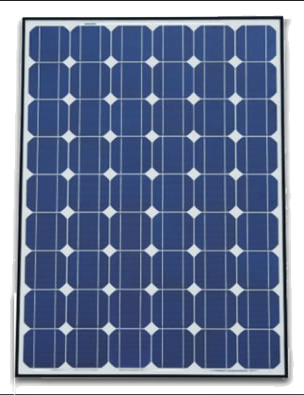Living Off The Grid
In West Branch Michigan
Solar
Introduction

Power from the sun. Solar panels actively convert solar energy into electrical energy. Solar cells are arraigned into a grid and a number of them are wired together to form a solar panel. These Photovoltaic (PV) panels are made of special materials called semiconductors. They do not have fluids or chemicals in them and they do not have any moving parts. When light energy strikes a PV cell a part of the energy is absorbed in the cell and that energy knocks electrons loose allowing the flow of electricity. Because of the nature of the semiconductor, the electrons freed by the light energy flows in a certain direction. This directional flow creates an electrical current. This current and voltage multiplied together equals the power or wattage of the solar panel. As more photovoltaic cells are connected together, the voltage of the electricity produced increases. Solar energy panels combine many cells to generate the electrical energy required for homes or devices. Where larger amounts of electricity are required, panels are linked together in arrays.
One of the problems with solar panels is that they only work in direct sunlight. They don't work at night or on cloudy days. Also, if any part of the panel is shaded then the efficiency of the entire panel is dramatically reduced. There are technologies that help midigate the shade tolerance of a panel but it comes with a cost. Another technology that helps in increasing the effiency of a panel is from Uni-Solar. They developed a technique that generates power by utilizing a triple junction solar cell that targest three different spectrums from the sunlight. This enables them to generate more power than they would otherwise.
Another way to get the most out of your solar panel is to make sure that the panel is mounted in such a way that it is always facing the sun. There are automated trackers available that will move your panels throughout the day to maintain the optimum angle. However, this adds more cost to the the system and it also increases the maintenance costs of the entire system. To get the most of a position-fixed photovoltaic panel you need to manually point them in the direction and angle that captures the most sun. This means that the panel should face true South in the Northern Hemisphere tilted from the horizontal at a degree equal to your latitude plus 15 degrees in the winter and minus 15 degrees in the summer.
My System
Since my system is small and my budget even smaller I decided to install one photovoltaic panel to charge my batteries. I went with the Uni-Solar 64watt photovoltaic panel. At the time it was the largest wattage panel Uni-Solar made. From researching the issue, I found that in my area I could expect on average three hours of full sun per day. That would mean that over a week I could expect to generate 1,344watts of energy over a one week period (64watts * 3hours * 7days = 1,344watts). To determin my peak sun-hours I used this link to calculate my wattage: Global Peak Sun-hour Maps
I configured my initial setup to fit in a plastic shed and I mounted my solar panel to the top of the shed. I made sure that the top of the shed would get full sun throughout the day without any shading from and nearby trees. I also created a mounting system for the panel so that I could adjust the angle of the panel when the seasons changed.
Links
Below are some links where I did my research on Solar Panels.
- Uni-Solar
- Uni-Solar manufactures thin-film triple junction solar panels
- Energy Grid Bookstore
- Listing of books dedicated to the design and installation of solar systems